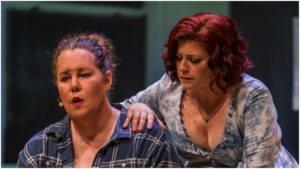
The Atlanta Opera 2021-22 Review: As One
Together Lucia Lucas & Blythe Gaissert Share Truth
By Afton Wooten(Credit: Raftermen)
Laura Kaminsky, Mark Campbell, and Kimberly Reed’s chamber opera “As One” has brought a newness to the opera stage through the kind of story they tell and created opportunities for opera professionals in the LGBTQIA+ community. In The Atlanta Opera’s production, starring Lucia Lucas as Hannah Before and Blythe Gaissert as Hannah After, the positive impact and need for this kind of work was evident.
“As One” shares the story of Hannah, the transgender protagonist in two roles: Hannah Before and Hannah After, in three parts. We see Hannah reflect on her childhood in a small town, her college days, and finally, we see Hannah in Norway where she finds solace in her true self.
The heaviness of Hannah’s story alongside the singers’ interpretations, music and musical direction, and the staging created a powerful experience.
Division & Alignment
Lucia Lucas’ masterful baritone encapsulated the text and Hannah’s raw emotion. In the opening number “Paper Boy,” Lucas established a clear contrast between when Hannah was suppressing her femininity and when Hannah was able to express herself. Her use of wide vowels and leaning into the musical dissonance versus a free, legato sound was carried through her entire performance, cueing the audience into Hannah’s internal struggle.
Similarly, Blythe Gaissert’s rich, smooth sound against the dissonance or in yielding to the harmony painted a vivid picture of Hannah’s feelings. Having been involved in “As One” since its days in workshop, Gaissert brought ease and solidity to her performance. Her flawless coloratura was the perfect fit for displaying Hannah’s freedom.
Together Lucas and Gaissert’s combined portrayals of Hannah had the right amount of disconnect and balance which resulted in an immersive and believable experience.
Expression
The string quartet under Alexandra Enyart’s baton encapsulated the rapport of the work. Kaminsky’s elaborate score helps drive the importance of the text which this group of musicians carried out nicely.
The cello accentuated the heavy moments, while matched with Lucas’ deep sound, created a grounded feeling. Continuously, the violins heightened the sense of fear, urgency, and discomfort. In Part II, “Out of Nowhere,” the climax to Hannah’s escape from an assault was timed to perfection. The sound and naming of victims of assault created a visceral uneasiness throughout the performance space.
During Part I, in “Entire of Itself” the quartet members and the conductor repeated the John Donne text “No Man is an Island” as if reciting in a classroom. Incorporating the quartet on stage and allowing the conductor to speak in the performance, I think helped unify the whole musical production and deepened the impact of the story.
Unity All Around
Stephanie Havey’s stage direction accompanied by Emma Antenen’s set design, and Erik Teague’s costume design simultaneously unified the production.
Havey’s staging truly captured the intimacy of the text. In the program notes, Havey credits historian Tony Butler’s concept of “memoryscapes” and the creation of “living map,” which is depicted in her stage direction. The execution of this concept with the visuals allowed for an intermingling of Hannah’s memories, thoughts, and reflections to be easily understood and performed.
Havey’s directorial choices were accentuated by the set design and costuming which meshed together through color and textures. The stage and props being completely white amplified the soft colors worn by the performers, and left no room for distractions from Hannah’s story.
The scrims on either side of the quartet and the paper lanterns which represented Hannah’s memories and letting go added a softness to the visual. The blue color on the flowing, ice-dyed costumes worn by both Hannahs and the orchestra added just enough color without being overpowering.
Teague’s most profound costuming choice was Hannah Before’s first costume – a semi-tattered, blue flannel with light pink bleach stains blending into the original blue color. Using the colors that have wrongly come to be associated with genders and the two colors merging together was thoughtful.
Final Reflections
While the performance itself was the main event and was extraordinary, the talk-back/Q&A afterward was of equal importance.
The environment which was created during Hannah’s story left the room feeling open and safe. I thought it was admirable that Atlanta Opera invited Queen Hatcher Johnson, a local trans community member who is the Gender Inclusive Program Manager at Positive Impact Health Centers. She was joined by Enyart who moderated, Lucas, Gaissert, Teague, and Kaminsky.
The floor was flooded with “thank yous” to the crew for their contributions to the trans community, specifically the trans musical community. Questions were asked about the process of writing this groundbreaking piece and working in new opera. The trans-identifying members on the panel were asked about connections to Hannah’s story and singing through transitioning. The space that was created and allowed for this conversation to happen is invaluable.
There was nothing in this production that did not leave me in awe. Every part of it was well-prepared, thoughtful, and deeply touching.


